A triple monitor setup is a significant upgrade for any workstation, offering an expansive digital canvas for immersive gaming, detailed financial analysis, or complex creative projects. However, three individual displays can quickly overwhelm a desk, leaving little room for anything else. A dedicated triple monitor mount is the solution, consolidating your screens into a single, ergonomic, and space-saving unit.
This guide provides a purely informational, objective analysis of prominent triple monitor mounts available. It will clarify the critical distinctions between wall-mounted and desk-mounted options and detail the key specifications you need to consider. Whether you’re building an immersive sim racing setup or a productivity powerhouse, this resource will help you understand the landscape of multi-monitor support.
Triple Monitor Mounts: 2025 Specifications at a Glance
This table offers a comprehensive, at-a-glance comparison of the models detailed in this guide. Specifications are based on the latest manufacturer information.
| Feature | HUANUO HN-TS3 | WALI GSDM003 | MOUNT-PRO PR1003-1 | JYLH Joy Seeker | Tripp Lite DMR1015X3 |
| Mount Type | Desk (Clamp/Grommet) | Desk (Clamp/Grommet) | Desk (Clamp/Grommet) | Desk (Freestanding) | Wall Mount |
| Max Monitor Size | Up to 32 inches | Up to 27 inches | Up to 27 inches | Up to 27 inches | Up to 15 inches |
| Weight Capacity | 17.6 lbs / 8 kg per arm | 15.4 lbs / 7 kg per arm | 17.6 lbs / 8 kg per arm | 17.6 lbs / 8 kg per arm | 18 lbs / 8.2 kg per mount |
| VESA Compatibility | 75x75mm, 100x100mm | 75x75mm, 100x100mm | 75x75mm, 100x100mm | 75x75mm, 100x100mm | 75x75mm, 100x100mm |
| Arm Mechanism | Gas Spring (Outer Arms) | Gas Spring (Outer Arms) | Gas Spring (All Arms) | Articulating Arms | Sliding Rail |
| Tilt Range | +90° / -45° | +90° / -45° | +90° / -90° | +15° / -15° | +15° / -15° |
| Swivel Range | ±90° | ±90° | ±90° | ±180° (outer arms) | ±20° |
| Rotation | 360° | 360° | 360° | 360° | 360° |
| Max Height | ~19.5 inches | ~17.1 inches | ~18.5 inches | ~16.1 inches | N/A (Wall Dependant) |
| Max Extension | ~27.1 inches | ~27.5 inches | ~27.1 inches | N/A | N/A (Fixed Depth) |
| Material | Aluminum, Steel | Aluminum, Steel | Alloy Steel | Aluminum, Steel | Alloy Steel |
| Cable Management | Integrated Clips | Integrated Clips | Integrated Clips | Integrated Clips | Rail Guides |
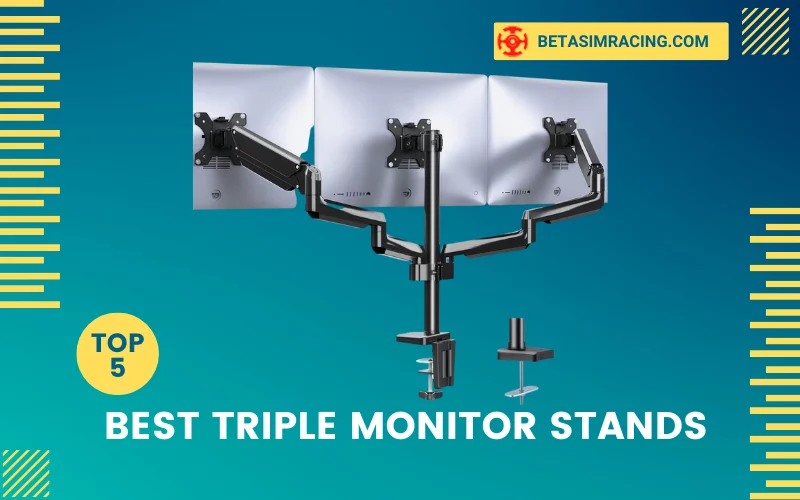
Essential Factors When Selecting a Triple Monitor Mount
Choosing the right mount involves more than just finding one that fits three screens. To ensure stability, compatibility, and ergonomic comfort, consider these critical factors.
Understanding VESA Compatibility
The VESA Interface Standard defines the distance between the four mounting holes on the back of a monitor. The most common patterns are 75x75mm and 100x100mm. Before selecting a mount, confirm the VESA pattern on your monitors to ensure they are compatible. Nearly all modern monitor mounts adhere to these standards.
Monitor Size and Weight Capacity
Every mount has a specified maximum monitor size and a weight capacity per arm. Adhering to these limits is crucial for safety and stability. While a mount may physically accommodate a larger screen, exceeding the weight limit can lead to sagging, instability, or catastrophic failure. For those using larger displays, such as when comparing an ultrawide vs. a regular monitor, checking these specifications is non-negotiable.
Mount Type: Wall-Mounted vs. Desk-Mounted
This is a primary decision point that dictates the entire setup.
- Desk-Mounted Stands: These are far more common for consumer and office setups. They attach to a desk via a C-clamp, a grommet hole, or a freestanding base. They offer excellent flexibility and are ideal for users who may want to reposition their entire workstation. However, they require a sturdy desk with sufficient thickness to support the clamp and the total weight.
- Wall Mounts: These are bolted directly into wall studs, offering maximum stability and completely freeing up desk space. They are a permanent solution, ideal for control rooms, digital signage, or dedicated setups where the position is fixed. Installation is more involved and requires locating wall studs. Users must be certain about monitor placement before drilling. Exploring whether you can mount a computer monitor on the wall is a good first step.
Adjustability and Ergonomics
The ability to adjust your monitors is key to preventing neck and eye strain. Key articulation features include:
- Tilt: The ability to angle the screen up or down.
- Swivel: The ability to turn the screen left or right.
- Rotation: The ability to pivot the screen between landscape and portrait orientations.
- Height Adjustment: The ability to move the monitors up and down to achieve eye level.
Mounts with gas spring arms offer the smoothest and most effortless adjustments, allowing you to reposition monitors with a light touch.
An In-Depth Look at 5 Popular Triple Monitor Solutions
Here is an objective, fact-based analysis of five distinct triple monitor mounting systems, based on their specifications. Note that four of these are desk mounts and one is a true wall mount.
HUANUO Triple Monitor Stand (Model HN-TS3)
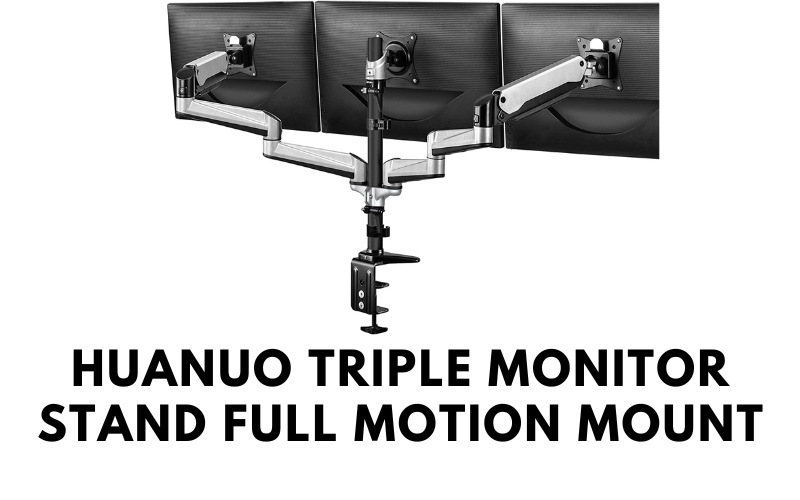
The HUANUO HN-TS3 is a desk-mounted stand known for its wide compatibility, supporting monitors up to 32 inches on its outer arms. It utilizes a combination of a static central pole and two full-motion gas spring arms on the sides. This hybrid design provides both stability for the central monitor and flexibility for the side displays.
- Mounting System: C-Clamp or Grommet Mount
- Material: Aluminum, Alloy Steel
- Key Features: The two outer arms feature gas springs for smooth height and position adjustments, while the central monitor’s height is adjusted on the main pole. It offers a full range of tilt, swivel, and rotation.
- Ideal Use Case: Users with a central primary monitor up to 32 inches who require flexibility for two smaller side monitors in a gaming or multitasking setup.
Objective Analysis: This model is a versatile choice for mixed-size monitor setups. The 17.6 lb per-arm weight capacity is standard for this category. The reliance on gas springs for the outer arms only is a design choice that prioritizes stability for the central screen while offering ergonomic adjustment for peripheral ones.
WALI Triple Monitor Gas Spring Desk Mount (Model GSDM003)
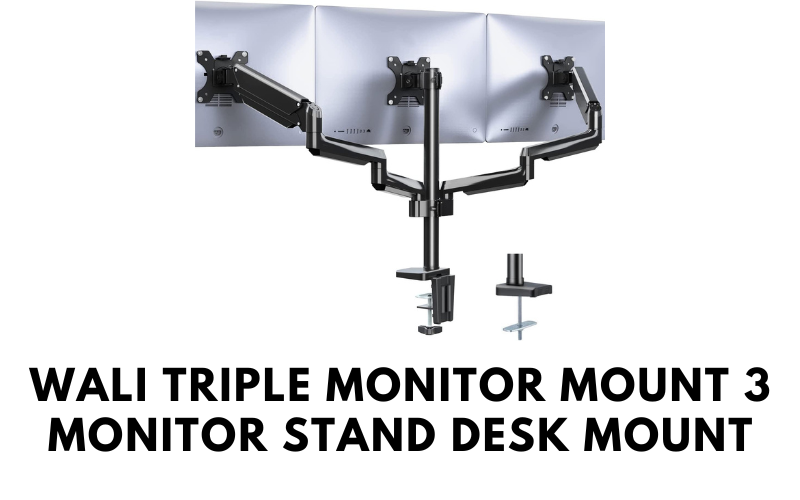
The WALI GSDM003 is another popular desk-mounted solution that supports three monitors up to 27 inches each. Similar to the HUANUO model, it uses a central fixed monitor position with two articulating gas spring arms for the side monitors. This model is often noted for including all necessary hardware and clear instructions.
- Mounting System: C-Clamp or Grommet Mount
- Material: Aluminum, Steel
- Key Features: Supports monitors up to 27 inches with a weight of 15.4 lbs per arm. The gas spring arms offer a wide range of motion, and the system includes integrated cable management clips to maintain a clean workspace. Some variants have been noted to include USB pass-through ports in the base.
- Ideal Use Case: Standard office or gaming setups using three monitors of the same size (up to 27 inches) where ergonomic adjustment of the side screens is a priority.
Objective Analysis: The WALI GSDM003 is a well-rounded and standard option in the desk mount category. Its weight capacity is slightly lower than some competitors, so verifying monitor weight is important. The potential inclusion of USB ports in the base adds a layer of convenience not found on all models.
MOUNT-PRO Triple Monitor Gas Spring Desk Mount (Model PR1003-1)
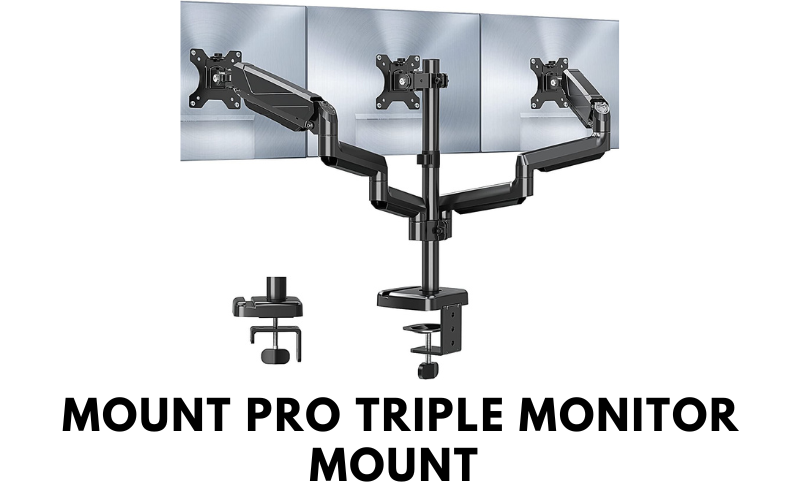
The MOUNT-PRO PR1003-1 differentiates itself by incorporating gas spring mechanisms on all three arms. This provides maximum and effortless adjustability for every monitor in the setup, not just the side screens. It is designed for users who frequently change the orientation or position of all their displays.
- Mounting System: C-Clamp or Grommet Mount
- Material: Alloy Steel
- Key Features: Full gas spring articulation for all three arms. It supports monitors up to 27 inches and 17.6 lbs each. This full-motion design allows for extensive tilt, swivel, and rotation capabilities for each screen independently.
- Ideal Use Case: Traders, developers, or content creators who need to constantly re-orient all three of their monitors (up to 27 inches) for different tasks, such as switching a central screen to portrait mode for coding.
Objective Analysis: The primary advantage of this mount is its universal gas spring design, offering superior flexibility compared to hybrid models. This makes it suitable for complex and dynamic workflows. The trade-off is often a higher price point and a more complex initial setup to balance the tension on all three arms.
JYLH Joy Seeker Aluminum Triple Monitor Stand
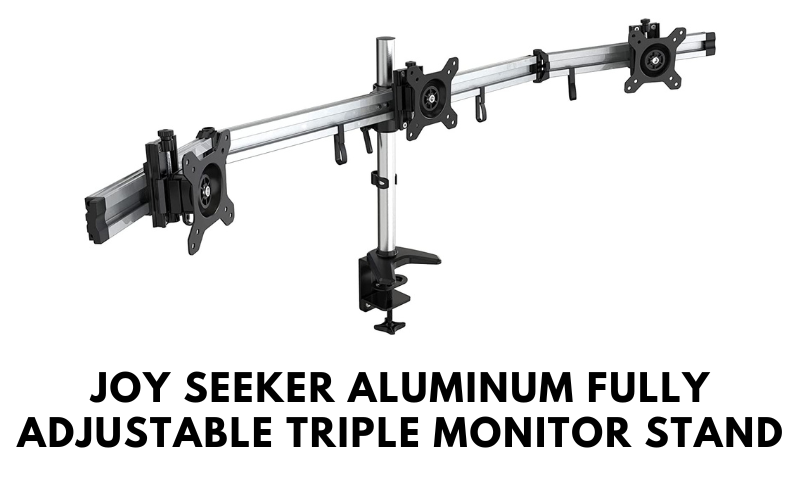
This model is a freestanding desk mount, which means it does not clamp to the desk. Instead, it relies on a large, weighted base for stability. This makes it suitable for desks where a clamp is not viable (e.g., glass tops or desks with a rear lip). The arms are articulating but do not feature a gas spring mechanism, meaning adjustments require manual loosening and tightening.
- Mounting System: Freestanding Base
- Material: Aluminum, Steel
- Key Features: Supports three monitors up to 27 inches and 17.6 lbs each. The primary benefit is its freestanding design. Adjustability is more basic, with tilt and rotation, but height is adjusted by moving the arms along the central pole.
- Ideal Use Case: Users who have desks that cannot accommodate a clamp or grommet mount, or who need to move the entire monitor setup frequently without detaching it from the desk.
Objective Analysis: The freestanding base is this unit’s defining feature, offering a solution for specific desk types. The lack of gas springs makes on-the-fly adjustments less convenient. It is a stable, but less flexible, alternative to the clamp-based models.
Tripp Lite Triple Flat-Panel Rail Wall Mount (Model DMR1015X3)
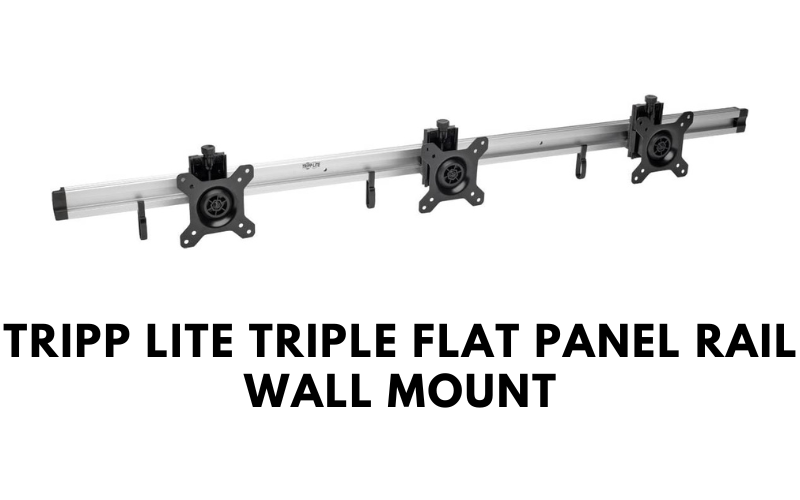
This is the only true wall mount in this list. The Tripp Lite DMR1015X3 consists of a long metal rail that is securely bolted to the wall. Three individual VESA mounts then slide along this rail, allowing you to position the monitors. It is designed for smaller displays, making it suitable for security stations or commercial digital signage.
- Mounting System: Wall Mount
- Material: Alloy Steel
- Key Features: A 50-inch horizontal wall rail. Supports three monitors up to 15 inches and 18 lbs each. The mounts can slide horizontally along the rail and offer tilt, swivel, and 360° rotation. This is a highly secure, permanent installation.
- Ideal Use Case: Commercial applications like menu boards, control rooms, or any situation requiring a permanent, secure wall installation of multiple small monitors.
Objective Analysis: The DMR1015X3 is a specialized product for a different use case than the desk mounts. Its small monitor size limit (15 inches) makes it unsuitable for typical triple-screen gaming or productivity setups. However, for its intended purpose of creating a secure, linear array of displays, it is a robust and effective solution. It is a successor to older, now discontinued models like the DWM3770PLX.
Frequently Asked Questions (FAQ)
Are triple monitor mounts worth it for gaming and productivity?
Absolutely. For productivity, they expand screen real estate, allowing you to view multiple applications or documents simultaneously without switching tabs. For gaming, especially sim racing games, they provide an immersive, panoramic view that can significantly enhance the experience.
How do I know if a mount will fit my monitors?
Check three things: your monitor’s VESA pattern (e.g., 100x100mm), its weight (without the stand), and its screen size. All three must be within the mount’s specified limits. You can find this information in your monitor’s user manual or on the manufacturer’s website.
What is the difference between a gas spring arm and a standard articulating arm?
A gas spring arm contains a pressurized cylinder that counterbalances the weight of your monitor, allowing for smooth, fingertip adjustments. A standard articulating arm requires you to manually loosen a joint, move the arm to the desired position, and then tighten it again. Gas springs offer far greater convenience for frequent adjustments.
Can you use different-sized monitors on a triple mount?
Yes, but with caveats. Some mounts, like the HUANUO model reviewed, are explicitly designed to handle a larger central monitor. For others, the primary constraint is ensuring the side monitors aren’t too wide to be angled in properly. Always check the mount’s maximum total width specification if available.
How important is cable management in a monitor mount?
Very important for a clean and functional setup. Good cable management, usually in the form of integrated clips or hollow channels in the arms, routes your power and display cables along the mount itself. This prevents a “rat’s nest” of wires, reduces clutter, and avoids snagging cables when you adjust the monitors.

With 15 years of experience as a PC hardware technician, Ben brings a practical, hands-on approach to our PC Components section. He specializes in real-world testing and longevity analysis, explaining how components perform over time. His guides help readers understand the practical side of owning and maintaining a gaming PC.
